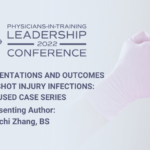Abstract | April 5, 2022
MYRIAD OF PRESENTATIONS AND OUTCOMES OF POST-GUNSHOT INJURY INFECTIONS: A FOCUSED CASE SERIES
Learning Objectives
- Understand manifestations and management of the various infectious sequelae of gunshot wounds.
Recovery from gunshot wounds (GSW) is often complicated by various infectious sequelae involving a broad spectrum of organisms. However, current guidelines on the risk stratification and management of post-GSW infections are lacking. Here, we present a case series highlighting the sheer variety of clinical courses and outcomes of post-GSW infections in hopes of inspiring future studies that will translate into life-saving guidelines.
A total of 25 patients were included for analysis (92% male, 73% African American, mean age=41 years, mean BMI= 25 kg/m2). The most common location of GSW was the abdomen, 82% received emergent surgical repair. The most frequently used prophylactic antibiotic regimen was cefazolin/cefoxitin (64%). 56% had some form of vascular access line, catheter, or hardware installed. The average duration from GSW admission to infection onset was 5.9 days, with skin and deep tissue infections being the most common type (32%). The most common therapeutic antibiotic combination was vancomycin with piperacillin-tazobactam and/or cefepime, seen in 24% of cases. The average duration from infectiononset to discharge was 24.9 days, with 68% being discharged to home.
Despite the limited number of patients studied, a large variety of post-GSW infectious modalities were observed, including bacterial or fungal cellulitis, osteomyelitis, bacteremia/fungemia, lung abscess/empyema, peritonitis, urinary tract infection, pseudomembranous colitis, and decubitus/pressure ulcer infections.
A broad range of infectious organisms were detected from blood, tissue, and other bodily fluid cultures. More common organisms included S.Aureus, Pseudomonas, E.Coli, and Bacteroides spp. Multi-drug resistance was seen frequently with Staphylococcus spp. Rarer organisms seen included E.Faecalis, Eikenella, C.Difficile, Candida, Stenotrophomonas, and Mucor spp.
Several chronic sequelae were observed, including nonhealing sacral ulcers, leukoclastic vasculitis, and infection-induced glomerulonephritis. These chronic conditions combined with permanent disabilities caused by GSW (e.g. neurogenic bladder/bowel and paraplegia/quadriplegia) can become a significant hinderance to patients’ return to usual quality of life.
Post-GSW infections are common and can involve highly varied presentations in different organ systems. Importantly, such complications can occur at either acute or chronic phases of patients’ recovery course. Larger prospective studies are needed to refine risk stratification and help clinicians better prevent permanent infectious sequelae or disabilities in these patients.

